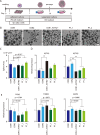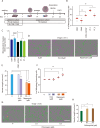Analysis of human neuronal cells carrying ASTN2 deletion associated with psychiatric disorders
- PMID: 38830862
- PMCID: PMC11148150
- DOI: 10.1038/s41398-024-02962-4
Analysis of human neuronal cells carrying ASTN2 deletion associated with psychiatric disorders
Abstract
Recent genetic studies have found common genomic risk variants among psychiatric disorders, strongly suggesting the overlaps in their molecular and cellular mechanism. Our research group identified the variant in ASTN2 as one of the candidate risk factors across these psychiatric disorders by whole-genome copy number variation analysis. However, the alterations in the human neuronal cells resulting from ASTN2 variants identified in patients remain unknown. To address this, we used patient-derived and genome-edited iPS cells with ASTN2 deletion; cells were further differentiated into neuronal cells. A comprehensive gene expression analysis using genome-edited iPS cells with variants on both alleles revealed that the expression level of ZNF558, a gene specifically expressed in human forebrain neural progenitor cells, was greatly reduced in ASTN2-deleted neuronal cells. Furthermore, the expression of the mitophagy-related gene SPATA18, which is repressed by ZNF558, and mitophagy activity were increased in ASTN2-deleted neuronal cells. These phenotypes were also detected in neuronal cells differentiated from patient-derived iPS cells with heterozygous ASTN2 deletion. Our results suggest that ASTN2 deletion is related to the common pathogenic mechanism of psychiatric disorders by regulating mitophagy via ZNF558.
© 2024. The Author(s).
Conflict of interest statement
Dr. N. Ozaki has received research support or speakers’ honoraria from or has served as a joint researcher with, or a consultant to, Sumitomo Pharma, Otsuka, Viatris, Eisai, Mochida, Kyowa Pharmaceutical Industry, Nihon Medi-Physics, Nippon Chemiphar, Medical Review, Nippon Boehringer Ingelheim, SUSMED, outside the submitted work.
Figures






References
-
- Saito M, Hirota T, Sakamoto Y, Adachi M, Takahashi M, Osato-Kaneda A, et al. Prevalence and cumulative incidence of autism spectrum disorders and the patterns of co-occurring neurodevelopmental disorders in a total population sample of 5-year-old children. Mol Autism. 2020;11:35. doi: 10.1186/s13229-020-00342-5. - DOI - PMC - PubMed
MeSH terms
Substances
Grants and funding
- JP21wm0425007/Japan Agency for Medical Research and Development (AMED)
- JP19dm0207075/Japan Agency for Medical Research and Development (AMED)
- JP19ak0101113/Japan Agency for Medical Research and Development (AMED)
- JP21dk0307103/Japan Agency for Medical Research and Development (AMED)
- JP22ek0109601/Japan Agency for Medical Research and Development (AMED)
LinkOut - more resources
Full Text Sources
Medical
Molecular Biology Databases

